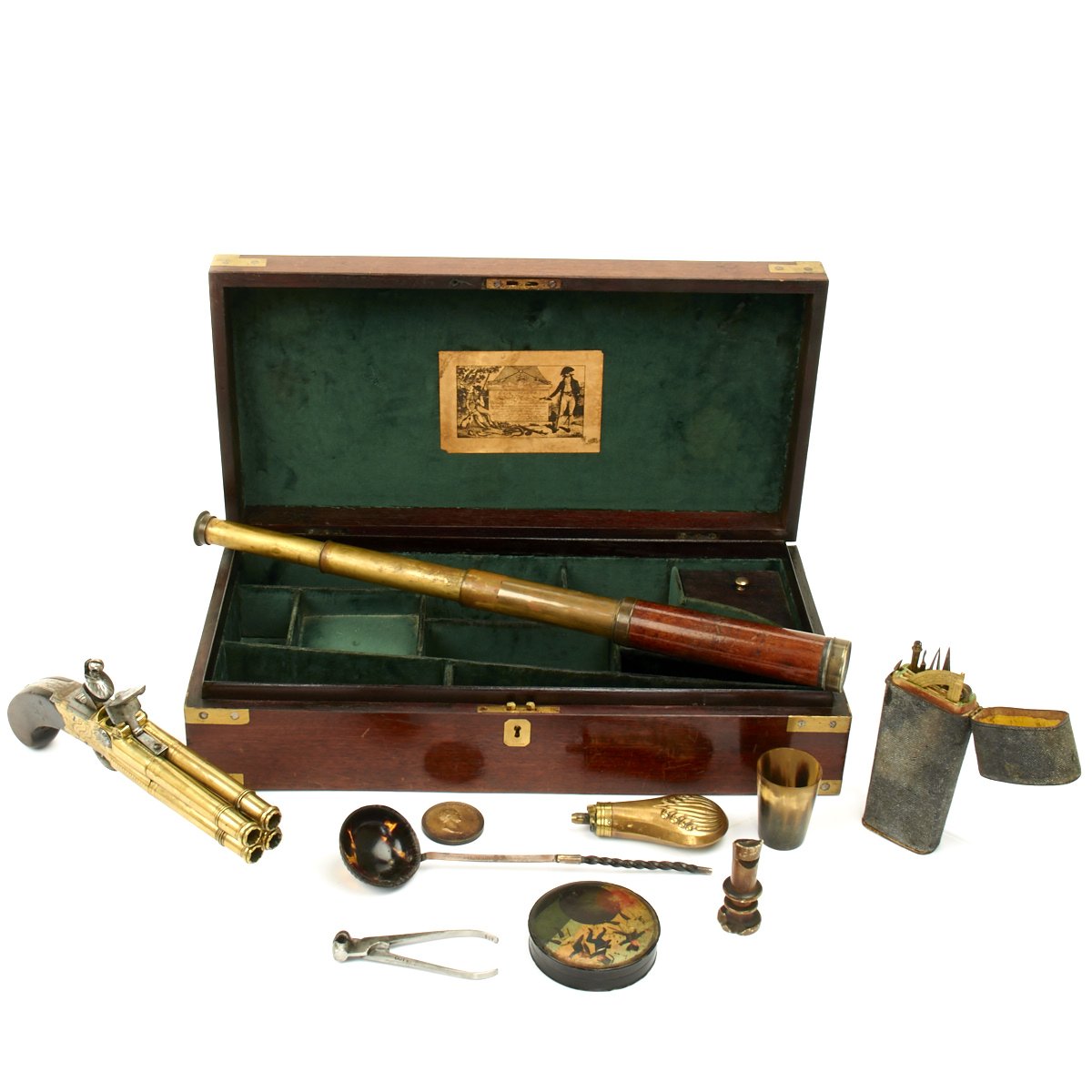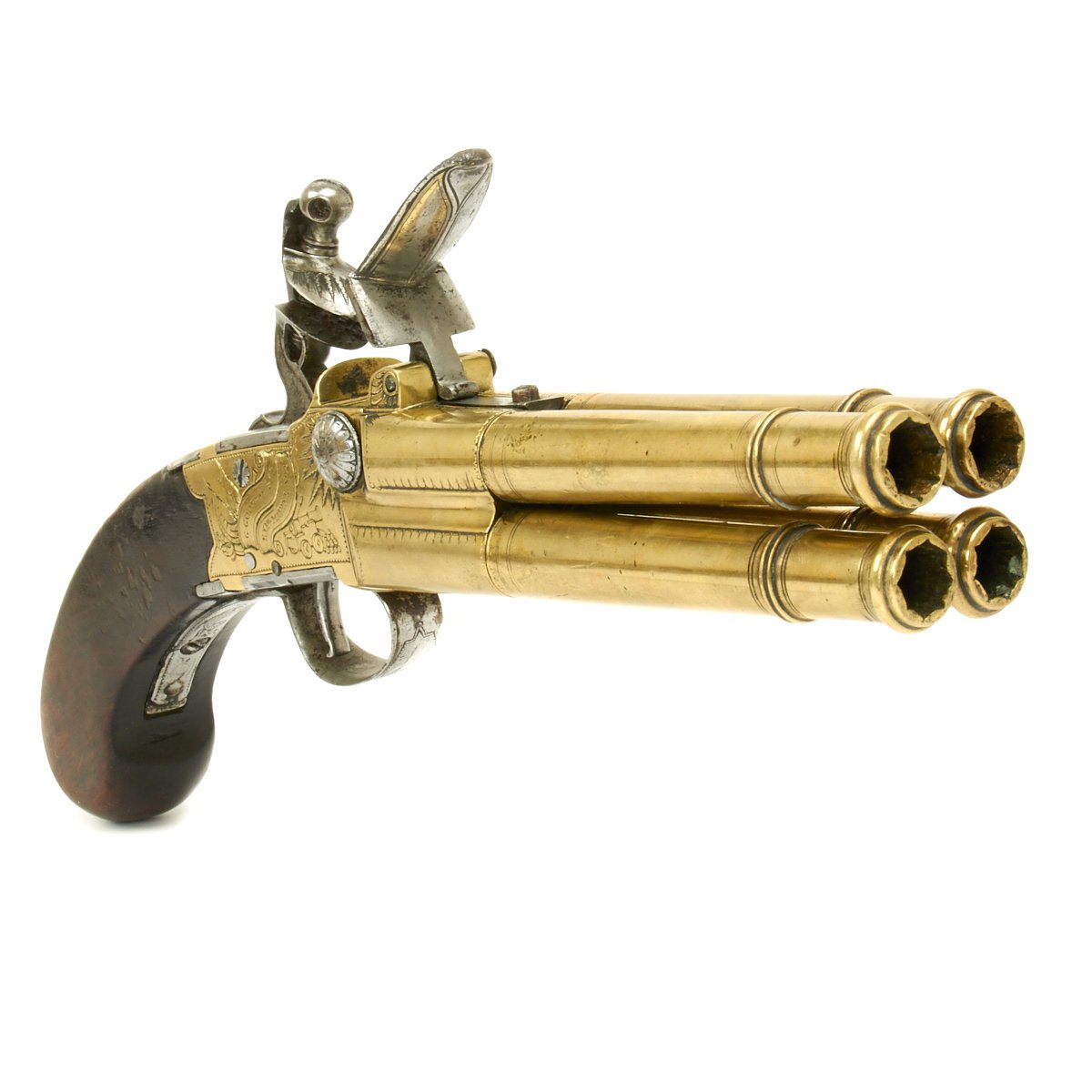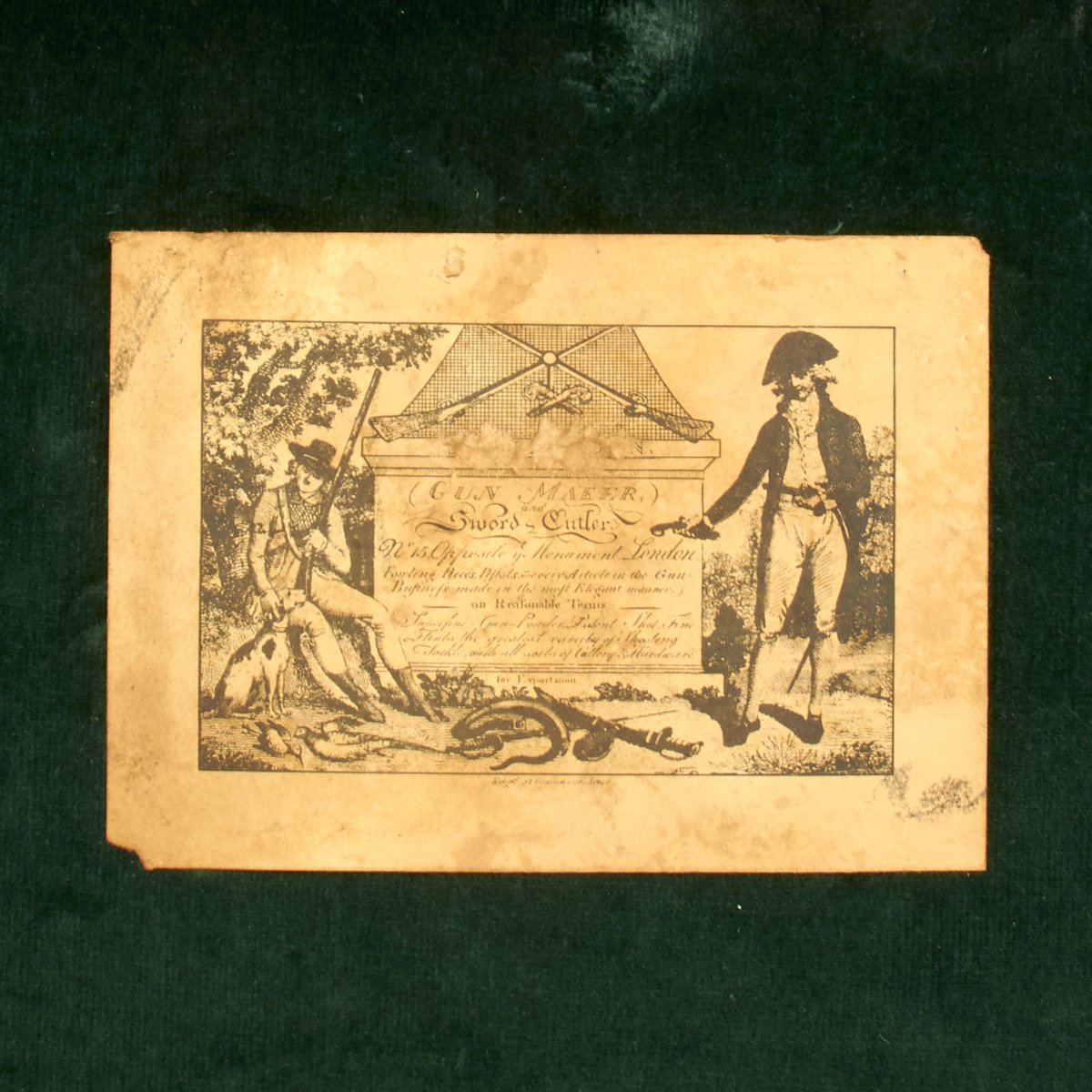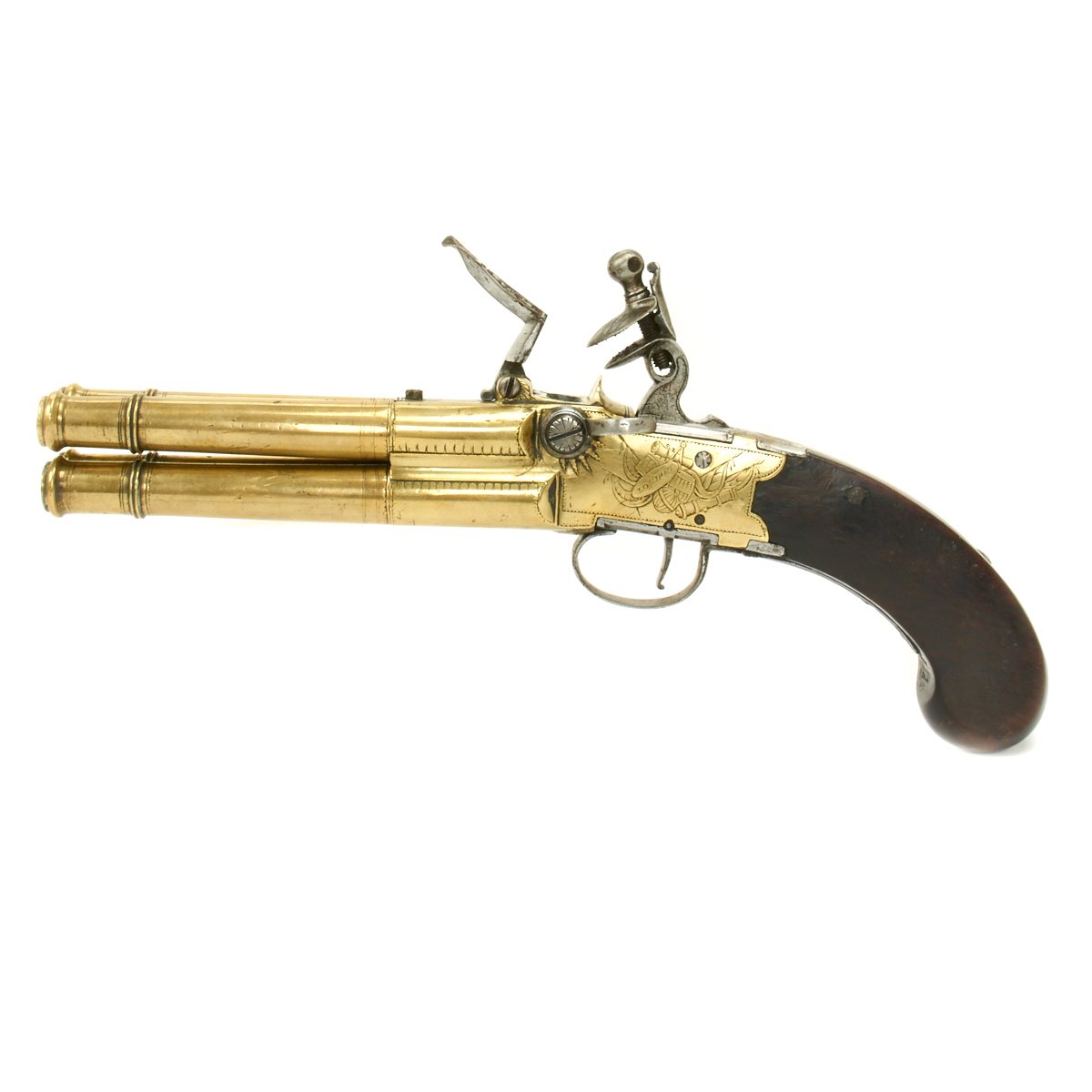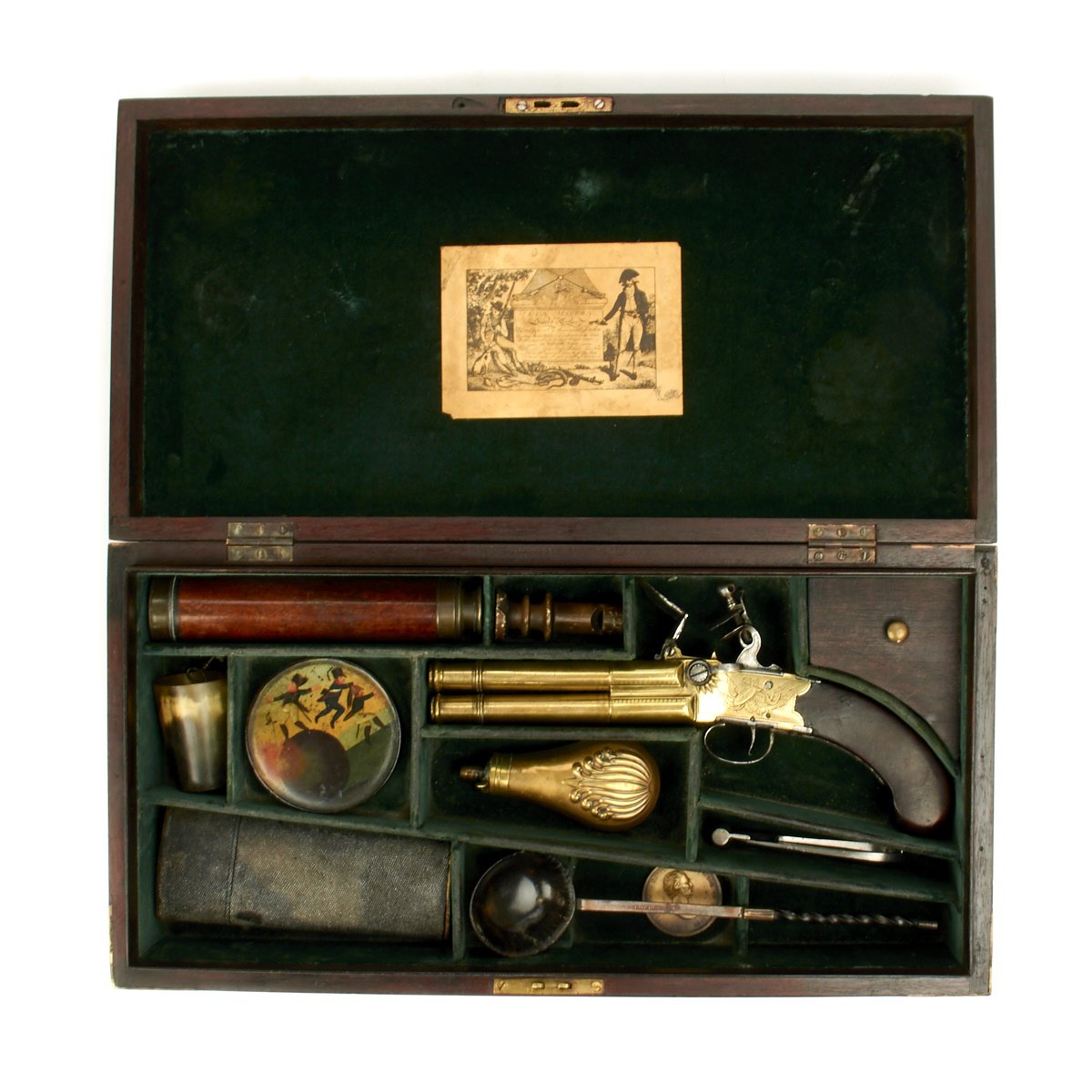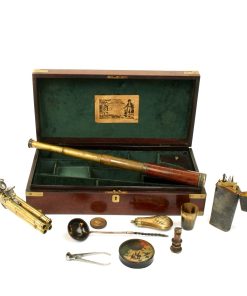Original British Napoleonic Wars Flintlock Volley Pistol Cased Set Named to Captain James Saumarez Original Items
$ 39.995,00 $ 9.998,75
Original Items: One-of-a-kind set. A fine brass framed flintlock volley pistol capable of firing four shots simultaneously designed in for use in close combat and mutiny situation. The four barrel pistol comes custom fit in wood case that also holds a powder flask, bullet mold, small telescope, cased set of Navigational instruments, tortoise shell ladle, and snuff box that depicts a hand painted Napoleon being “pushed” off the world.
The pistol is clearly marked:
G. GOODWIN & Co.
EXPL MARINE No. 2
LONDON
Gun Maker was George Goodwin who worked from 1770 until 1820. The pistol’s silver escutcheon is faintly engraved:
Capt
J. SAUMAREZ
The wood case features an inlaid brass plaque that is engraved:
CAPTAIN
J. SAUMAREZ
R.N.
Admiral James Saumarez, 1st Baron de Saumarez (or Sausmarez), GCB (11 March 1757 – 9 October 1836) was an admiral of the British Royal Navy, notable for his victory at the Battle of Algeciras. He also fought in American Revolutionary War, the Battle of Cape St Vincent, The Baltic Campaign and was an rival of Admiral Nelson.
Early service in the Mediterranean and American Revolutionary War
In 1767 Saumarez was entered as a volunteer on the books of HMS Solebay (1763) although he never set foot on the ship, studying at a school near London until in 1770, Saumarez joined the Montreal in the Mediterranean. Placed on board HMS Winchelsea (1764) he was rated Midshipman in November 1770. A transfer to HMS Levant (1758) in February 1772 until she returned to Spithead in 1775 gave an opportunity to take his examination for Lieutenant.
In 1775, at the age of 18, he was ordered to Sir Peter Parker’s flagship HMS Bristol in North America. Saumarez distinguished himself under Parker, showing courage and being promoted to acting lieutenant at the July 1776 Battle of Sullivan’s Island which required the Bristol to fire broadsides at Fort Sullivan. The engagement lasted 13 hours and 111 men were killed on the Bristol.
Moved to HMS Chatham (1758) as temporary 5th lieutenant, he was given his first command, the tender Lady Parker. On promotion to lieutenant in 1778 he was given his second command, the 8-gun galley Spitfire and after 47 engagements, unfortunately, he had to run Spitfire ashore and burn her on 30 July 1778 when a French fleet under Admiral d’Estaing arrived at Narrangansett Bay. Serving on land at the Battle of Rhode Island before returning to Portsmouth.
Saumarez next served as third lieutenant on the Victory, under various admirals until it became Vice Admiral Hyde Parker’s flagship, by which time he had moved up to 1st lieutenant. He moved with the Admiral to HMS Fortitude, on which he was present at the Battle of Dogger Bank on 5 August 1781, when he was wounded. He was promoted commander and appointed to the fireship Tisiphone. In 1782, Saumarez sailed his ship to the West Indies with despatches for Samuel Hood and arrived in time to witness the closing stages of Hood’s operations at St Kitts on 25 January 1782.
Battle of the Saintes
While commanding the HMS Russell (74 guns), he contributed to Rodney’s victory over de Grasse at the Battle of the Saintes on (12 April 1782). During the battle and on his own initiative, Saumarez took his ship out of line to assist in the capture of De Grasse’s flagship, Ville de Paris. This action prompted Admiral Rodney to remark that, “The Russell’s captain is a fine fellow, whoever he is.”
When the war in America was finished, Saumarez went ashore and did not go to sea again until 1793 when he was given command of the frigate HMS Crescent, a 36-gun fifth rate frigate.
Action of 20 October 1793
It was in Crescent that Saumarez was involved in one of the first major single-ship actions of the war when he captured the French frigate Reunion, in the Action of 20 October 1793. British casualties were exceptionally light, with only one man wounded during the engagement. In reward, Saumarez was knighted by King George III and given a presentation plate by the City of London, although he later received a bill for £103 6s 8d (the equivalent of £9,700 as of 2011), from a Mr. Cooke for “the honour of a knighthood”. Saumarez refused to pay, telling Cooke to charge whomever had paid for Edward Pellew’s knighthood after his successful action. Saumarez later wrote to his brother that “I think it hard to pay so much for an honour which my services have been thought to deserve”.
Channel Islands station
While in command of a Guernsey-based squadron consisting of three frigates, HMS Crescent (1784), HMS Druid (1783) and HMS Eurydice (1781), a lugger, and cutter a planned invasion by 20,000 French soldiers of the Channel Islands scheduled for February 1794 was frustrated and cancelled due to Saumarez’s vigilant eye. On 8 June 1794 on the way from Plymouth to Guernsey, he encountered a superior French force of two razees, three frigates, and a cutter. The French squadron outgunned the British by 192 guns to 92, but Saumarez succeeded in getting his frigates to safety by sailing between rocks on the west coast of Guernsey and around the island to the St Peter Port anchorage. The British lugger and cutter had returned to Plymouth before the start of the action. The British threat to any invasion force stayed intact.
Battle of Cape St Vincent
After being promoted in 1795 he was appointed to the 74-gun HMS Orion in the Channel fleet, where he took part in the defeat of the French fleet at the Battle of Groix off Lorient on 22 June. Orion was one of the ships sent to reinforce Sir John Jervis in February 1797, when Saumarez distinguished himself in the Battle of Cape St. Vincent. During the early stages he helped repel a sustained attack on the British line and covered the retreat of HMS Colossus when she was forced to retire from the action. Colossus had sustained serious damage, her sails being virtually shot away and it looked as though she would be raked by Spanish warships, until Orion intervened. Later, when the engagement had turned to a general melee, Saumarez forced the Salvador del Mundo to surrender before attacking the Santissima Trinidad with the help of HMS Excellent. Saumarez was certain he had forced her surrender too when the arrival of the remainder of the Spanish fleet forced Jervis to break off the engagement.
Blockade of Cadiz and the Battle of the Nile
Saumarez remained with Jervis’s fleet and was present at the blockade of Cadiz from February 1797 to April 1798. In May 1798, the Orion joined the squadron under Nelson’s command that was sent into the Mediterranean to seek and destroy the French. Saumarez was Nelson’s second in command at the Battle of the Nile where he distinguished himself once more, forcing the surrender of the Peuple Souverain and the 80-gun Franklin.
Battle of Algeciras and Gut of Gibraltar
On his return from Egypt he received the command of HMS Caesar, of 80 guns, with orders to watch the French fleet off Brest during the winters of 1799 and 1800. In 1801, he was promoted to the rank of Rear Admiral of the Blue, was created a baronet, and received the command of a small squadron which was to watch the movements of the Spanish fleet at Cadiz. Between 6 and 12 July, he performed an excellent piece of service, in which after a first repulse at Algeciras he routed a much superior combined force of French and Spanish ships at the Battle of the Gut of Gibraltar. For his services, Saumarez received the Order of the Bath and the Freedom of the City of London. In 1803, the United Kingdom Parliament bestowed upon him an annuity of £1200 a year (Annuity to Admiral Saumarez Act 1803).
During the Peace of Amiens, 1802-3 Saumarez remained at home with his family in Guernsey, and when war broke out again he was given command of the naval forces defending the Channel Islands. He therefore was not present at the 1805 Battle of Trafalgar.
The Baltic Campaign
In 1808 he was given command of the Baltic fleet with his flag in HMS Victory. Saumarez’s mission was to protect the British trade which was of vital importance for Royal Navy supplies and to blockade enemy ports such as those under French control in northern Germany. The Russian fleet was also kept under blockade until Alexander I reopened Russian ports. Sweden, under pressure from France, declared war on Britain in November 1810 but Saumarez showed conspicuous tact towards the government of Sweden and her shipping, correctly guessing that the Swedes, like their Russian neighbours, would eventually defy Napoleon. Charles XIII later bestowed on him the Grand Cross of the military Order of the Sword. Denmark, a French satellite, also needed to be kept under observation until it was invaded by the Swedish Army in 1814. In 1812 Napoleon invaded Russia with half a million troops and Saumarez’s fleet was instrumental in hampering French operations.
Latter years
At the Peace of 1814, Saumarez attained the rank of Admiral, and in 1819 he was made Rear-Admiral of the United Kingdom, in 1821 Vice-Admiral of the United Kingdom. From 1824 to 1827 he was Commander-in-Chief, Plymouth. He was raised to the peerage as Baron de Saumarez in 1831 and died in Guernsey in 1836. In memory of Saumarez’s achievements, there is a statue of him in the National Maritime Museum in London. The public bar at the Duke of Normandie Hotel in Saint Peter Port was named after Saumarez and features a portrait of him.
Relationship with Nelson
Saumarez and Nelson served together in 1797 and 1798, but their relationship was not a close one. In fact on a number of occasions it became quite strained. They first clashed after the Battle of Cape St Vincent. Saumarez had forced the surrender of the Santissima Trinidad but was unable to capture her because Jervis was forced to break off the engagement. Nelson attempted to console Saumarez by telling him that the Spanish had confirmed that the Trinidad had indeed surrendered. Saumarez tersely replied “Whoever doubted it, sir? I hope there is no need for such evidence to establish the truth of a report of a British officer.”
In May 1798, when Saumarez was appointed to Nelson’s squadron in the Mediterranean, Nelson preferred to confer with Troubridge and even though, as the senior captain, Saumarez was technically second in command, he was often left out of their conversations.
After the Battle of the Nile, while in conversation with Nelson, on the quarterdeck of HMS Vanguard, Saumarez suggested that the tactic of doubling the French line had been a dangerous one as it exposed British ships to ‘friendly fire’. Before he had a chance to explain, Nelson cut him short and angrily went below. Nelson decided that Saumarez should escort the prizes home and they never served together again.
Later Nelson wrote a letter saying, “I could have formed no opinion of Orion that was not favourable to her gallant and excellent commander (Saumarez) and crew”. However, the awkwardness between them remained.
Fast Shipping with Professional Packaging
Thanks to our longstanding association with UPS FedEx DHL, and other major international carriers, we are able to provide a range of shipping options. Our warehouse staff is expertly trained and will wrap your products according to our exact and precise specifications. Prior to shipping, your goods will be thoroughly examined and securely secured. We ship to thousands clients each day across multiple countries. This shows how we're dedicated to be the largest retailer on the internet. Warehouses and distribution centres can be located throughout Europe as well as the USA.
Note: Orders with more than one item will be assigned a processing date depending on the item.
Before shipping before shipping, we'll conduct a thorough inspection of the items you have ordered. Today, the majority of orders will be delivered within 48 hours. The delivery time will be between 3-7 days.
Returns
The stock is dynamic and we cannot completely manage it because multiple stakeholders are involved, including our factory and warehouse. So the actual stock may alter at any time. It's possible that you may not receive your order once the order has been made.
Our policy is valid for a period of 30 days. If you don't receive the product within 30 days, we are not able to issue a refund or an exchange.
You can only return an item if it is unused and in the same state as the day you received it. You must have the item in its original packaging.
Related products
Uncategorized
Uncategorized
Uncategorized
Uncategorized
Uncategorized
Uncategorized
Uncategorized
Uncategorized
Band of Brothers ORIGINAL GERMAN WWII Le. F.H. 18 10.5cm ARTILLERY PIECE Original Items
Uncategorized
Armoured Fighting Vehicles of the World: AFVs of World War One (Hardcover Book) New Made Items
Uncategorized
Angolan Rebel 1970s era 60mm Inert Display Mortar from Angolan Civil War Original Items
Uncategorized
Uncategorized
Armored Burgonet Helmet & Polearm from Scottish Castle Leith Hall Circa 1700 Original Items
Uncategorized
Uncategorized
Uncategorized
Uncategorized
Uncategorized
